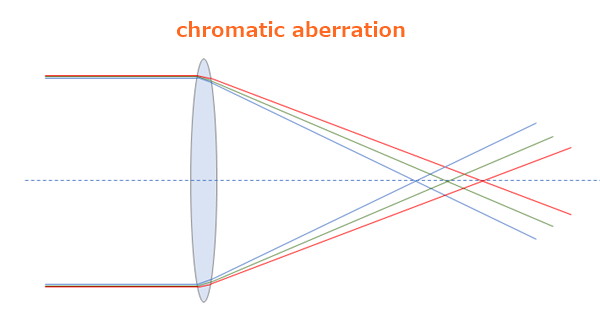When I was in elementary school, I found two convex lenses in the science room. I asked the teacher if I could have them and brought them home to make a telescope.
I found a solid paper tube in a closet and attached these lenses. Two hours later, I took my first homemade telescope outside and looked through it. The image was far less impressive than I’d anticipated, mainly because there were a lot of colors, like a rainbow on the fringes of the objects I was looking at.
I later learned this is called ‘chromatic aberration,’ which is a major downside of refracting telescopes.
Refracting telescopes suffer from such chromatic aberration. Binoculars work the same way as
refracting telescopes, so some chromatic aberration cannot be avoided.
I will explain what it is, how it’s caused, and tell you how to reduce it.
How chromatic aberration is caused
Binoculars are basically refracting telescopes with prisms. Although the prisms do reflect the light, they
do not perform as the objective lenses do in refracting telescopes. The prisms are there to correct the
orientation of the image and allow the binoculars to be more compact in size.
After passing through the objective lenses, the light is reflected through the prisms and ends up at the
focal point. However, as with refracting telescopes, all the colors do not focus at the same point.

The focal point varies according to the wavelength of light (see above), which is called axial aberration.
Looking at a white point of light and focusing on the blue light, you can see a red fringe around the
image.
The other kind of chromatic aberration is called transverse aberration: when different wavelengths are
focused at different positions in the focal plane, which leads to the aberration of color around the
fringes of an object.
Axial aberration occurs throughout an image, and transverse aberration increases around the edges of
an image. As both aberrations occur at the same time, the image in the peripheral area gets poorer.
Countermeasure to reduce the chromatic aberration
One of the most effective ways to reduce chromatic aberration is to use an achromatic lens or achromat. Chromatic aberration can be greatly minimized by combining crown and flint glass lenses (see below).

These two optical glasses have different refractive indexes and dispersions, so the focal points for
different colors get closer. Though achromatic lenses are not perfect, they are a great improvement.
Another breakthrough in correcting chromatic aberration is the emergence of new materials such as
fluorite crystal and Extra-low dispersion (ED) glass.
Technically, since fluorite is a crystal rather than a glass, while an excellent material, it is soft and
difficult to polish. Thus, fluorite lenses are still not common.
On the other hand, ED lenses are being used more and more in good binoculars. ED glass does not
spread the color spectrum as much as ordinary optical glass. It used to be expensive, but as technology advances, binoculars made with ED lenses are more affordable now.
Here is a comparison of an ordinary achromatic lens and an ED lens. You can see chromatic aberration
easily when looking at something like a branch or an electrical wire on a white background, such as a
cloud.

Left: ED binoculars 8×42, Right: ordinary achromatic doublet binoculars 7×35. You notice a subtle purple fringe at the edge of wires.
ED lenses cannot remove chromatic aberration completely, but they work well enough. Generally
speaking, the larger the aperture, the more chromatic aberration occurs. So, ED lenses are mainly used
for binoculars over 40mm.
Summary
Chromatic aberration cannot be avoided with refracting telescopes, including binoculars. It occurs
because each wavelength of light has its own focal point.
There are two ways to reduce chromatic aberration. One is to combine two different types of optical
glass so that visible light wavelengths have almost the same focal length. This is called an achromatic
lens.
The other way to minimize aberration is to use Extra-low Dispersion (ED) lenses. As manufacturing
technology advances, these have become more affordable.
When you want to buy a pair of binoculars with objective lenses over 40mm, it is important to check
whether they have ED lenses or not.
